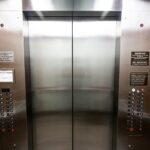Electric traction elevators play a vital role in ensuring the smooth and efficient transportation of people and goods within buildings. However, when these elevators begin to experience leveling issues, it can lead to frustrating inconveniences and potentially unsafe situations. Leveling problems occur when an elevator doesn’t align precisely with the floor, creating a noticeable step that can be hazardous for passengers stepping in or out.
Addressing leveling issues in electric traction elevators is important for user safety and maintaining the overall efficiency of the building’s vertical transportation system. When elevators operate smoothly and stop level with the floor, they provide an enhanced user experience and help prevent accidents. Understanding the common causes and solutions for leveling problems can aid building managers and maintenance teams in ensuring these elevators continue to function effectively.
Common Causes of Leveling Issues
Leveling issues in electric traction elevators can stem from a variety of factors. Knowing these common causes can help diagnose and resolve the problems quickly.
– Mechanical Wear: Over time, the parts of the elevator, such as the ropes and pulleys, can wear down. This wear can lead to imbalances or misalignments that affect the elevator’s ability to stop level with each floor.
– Sensor Malfunctions: Elevators rely on sensors to position themselves accurately. If these sensors become faulty or dirty, they might send incorrect signals, causing the elevator to stop unevenly.
– Electrical Interruptions: Power fluctuations can impact the elevator’s operation. Sudden losses or surges of power might disrupt the elevator’s ability to function smoothly, leading to unlevel stops.
Identifying the cause of a leveling issue is the first step toward finding the right fix. For example, if mechanical wear is the culprit, replacing or repairing specific components can remedy the issue. Similarly, cleaning or recalibrating sensors may resolve problems stemming from sensor malfunctions. By addressing these causes, elevator systems can maintain their reliability and safety.
Diagnosing the Problem
Before finding a solution for leveling issues, it’s important to understand the problem’s full scope. Building managers can start by looking for some common signs of trouble. Uneven floor stops are one of the most obvious indicators, creating a trip hazard that can be quite dangerous. This misalignment can vary, sometimes being just a small gap while other times, it might resemble a step.
Frequent adjustments needed by users, where passengers have to step up or down noticeably, point to such leveling problems. A good clue is when passengers consistently mention that they feel a bump or jolt when the elevator comes to a halt. Additionally, if the elevator overshoots its floor and then corrects itself, it signals that the leveling isn’t quite right.
Here’s a quick checklist to diagnose:
– Check if the elevator consistently stops just above or below the floor level.
– Listen for recurring complaints or feedback from passengers about uneven stops.
– Observe for sudden stops followed by corrections during landing.
Once these signs are noted, digging deeper with professional help is advisable. Technicians can run tests to precisely identify the root of the issue, ensuring that the correct areas are targeted for repair.
Solutions for Leveling Issues
After pinpointing the issue, addressing leveling problems in electric traction elevators becomes the next step. Here’s a basic roadmap to follow for tackling these issues effectively:
1. Regular Maintenance: Routine checks keep the elevator system healthy. Ensuring moving parts are in top shape can prevent minor hiccups from turning into major problems. Regular lubrication, checking of mechanical components, and ensuring that everything is working smoothly keeps the system functioning well.
2. Calibration of Sensors: Since sensors play a critical role in elevator leveling, they should be checked and calibrated regularly. Accurate sensors mean accurate stops, and when these sensors are calibrated, it prevents the frequent need for adjustments.
3. Professional Inspection: Relying on experts for detailed assessments can root out hidden issues. A professional inspection involves checking everything from the elevator’s control systems to its mechanical parts, ensuring all elements work harmoniously.
Each step in this process contributes to smoother, safer elevator operations, minimizing disruptions and making sure that passengers can rely on the elevator every day.
Preventative Maintenance
Ensuring that electric traction elevators operate without a hitch means placing a strong emphasis on preventative maintenance. This proactive approach not only prevents issues from developing but also extends the lifespan of the elevator system. Here are some strategies for maintaining elevators in peak condition:
– Scheduled Check-Ups: Regularly scheduled inspections mean catching issues early. These check-ups should involve looking at all major components, from mechanical workings to wiring, and everything in between.
– Routine Cleaning and Calibration: Keeping components clean prevents the buildup of dirt that might affect their function, especially sensors. Regular calibration of these sensors ensures they send accurate signals, which is vital for smooth stops.
– Engaging Professional Services: Though in-house efforts can handle basic tasks, professional services bring a depth of expertise that catches what might be missed. These services can provide comprehensive checks that guarantee nothing is overlooked.
By adhering to these maintenance strategies, building managers can enjoy the peace of mind that comes with elevators functioning optimally. Not only does this make for happy building occupants, but it also enhances overall building safety.
Smooth and Safe Operation
When leveling issues are properly addressed and preventative measures are in place, electric traction elevators operate with efficiency and reliability. This attentiveness means users can expect a seamless and safe ride experience every time. A proactive approach leads to fewer disruptions, helping maintain trust in the building’s infrastructure.
Keeping leveling issues at bay means engaging in regular maintenance routines, ensuring sensors and mechanical parts are functioning correctly, and opting for professional evaluations when necessary. These combined efforts mean that occupants aren’t just relying on hope for a smooth journey—they’re counting on an optimally functioning system that prioritizes their safety and comfort.
For seamless and reliable elevator performance, addressing leveling issues in electric traction elevators is essential. At Kaiser Elevators, we specialize in maintaining the safety and efficiency of your systems to keep passengers secure. Trust our expertise to pinpoint and resolve leveling problems, ensuring smooth operations that enhance user experience and building functionality. Contact us today.

